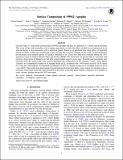Surface Composition of (99942) Apophis
Author(s)
Reddy, Vishnu; Sanchez, Juan A.; Furfaro, Roberto; Le Corre, Lucille; Hardersen, Paul S.; Bottke, William F.; Brozovic, Marina; Binzel, Richard P; Burbine, Thomas; ... Show more Show less
DownloadReddy_2018_AJ_155_140.pdf (1.816Mb)
PUBLISHER_POLICY
Publisher Policy
Article is made available in accordance with the publisher's policy and may be subject to US copyright law. Please refer to the publisher's site for terms of use.
Terms of use
Metadata
Show full item recordAbstract
On 2029 April 13, near-Earth asteroid (NEA) (99942) Apophis will pass at a distance of ∼6 Earth radii from Earth. This event will provide researchers with a unique opportunity to study the effects of tidal forces experienced by an asteroid during a close encounter with a terrestrial planet. Binzel et al. predicted that close flybys of terrestrial planets by NEAs would cause resurfacing of their regolith due to seismic shaking. In this work, we present the best pre-encounter near-infrared spectra of Apophis obtained so far. These new data were obtained during the 2013 apparition using the NASA Infrared Telescope Facility (IRTF). We found that our spectral data is consistent with previous observations by Binzel et al. but with a much higher signal-to-noise ratio. Spectral band parameters were extracted from the spectra and were used to determine the composition of the asteroid. Using a naïve Bayes classifier, we computed the likelihood of Apophis being an LL chondrite to be >99% based on mol% of Fa versus Fs. Using the same method, we estimated a probability of 89% for Apophis being an LL chondrite based on ol/(ol+px) and Fs. The results from the dynamical model indicate that the most likely source region for Apophis is the ν6resonance in the inner main belt. Data presented in this study (especially Band I depth) could serve as a baseline to verify seismic shaking during the 2029 encounter.
Date issued
2018-03Department
Massachusetts Institute of Technology. Department of Aeronautics and Astronautics; Massachusetts Institute of Technology. Department of Earth, Atmospheric, and Planetary SciencesJournal
The Astronomical Journal
Publisher
American Astronomical Society
Citation
Reddy, Vishnu, Juan A. Sanchez, Roberto Furfaro, Richard P. Binzel, Thomas H. Burbine, Lucille Le Corre, Paul S. Hardersen, William F. Bottke, and Marina Brozovic. “Surface Composition of (99942) Apophis.” The Astronomical Journal 155, no. 3 (March 5, 2018): 140.
Version: Final published version
ISSN
1538-3881